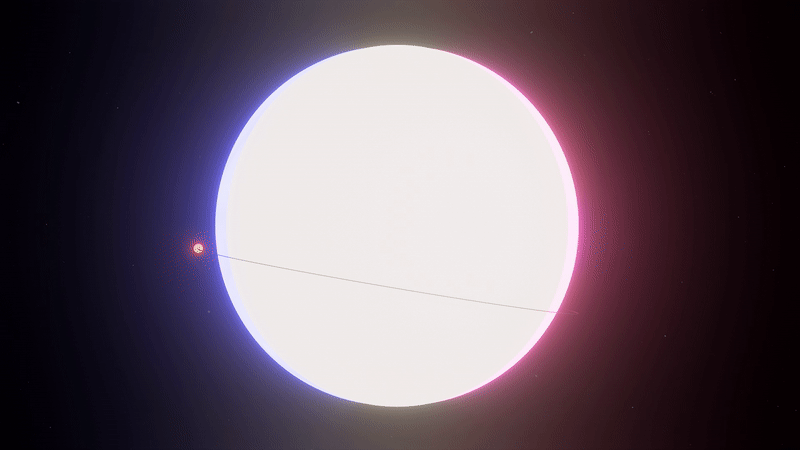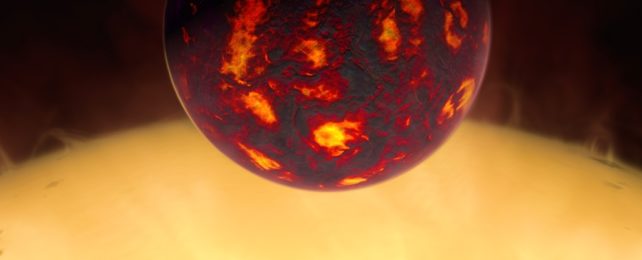An exoplanet so close to its host star that its surface is probably an ocean of magma just became the case study that may reveal how these extreme worlds come into being.
The "hell planet" in question is called 55 Cancri e (aka Janssen) and a new analysis of its orbit and the orbits of the other exoplanets circling the star reveals that Janssen most likely formed much farther out from the star, moving slowly towards it over time and melting in the process.
"We've learned about how this multi-planet system – one of the systems with the most planets that we've found – got into its current state," says astrophysicist Lily Zhao of the Flatiron Institute in New York.
All planetary systems have their quirks, but the Copernicus system, located some 41 light-years away (practically right next door), has some quirks of its very own. Aside from Janssen, five exoplanets orbit the star: Galileo, Brahe, Harriot, and Lipperhey, and all are more distant from Copernicus than their weirdo sibling.
With the closest orbit, Janssen swings round it star, called Copernicus (an orange dwarf just a little smaller than the Sun), about once every 18 hours. It's 1.85 times the radius of Earth and around 8 times its mass. That means it's a little denser than Earth and could have been a fairly normal rocky super-Earth at a greater distance from its star.
But it's not. It definitely is not.
Temperatures on the side facing the star average at 2,573 Kelvin (2,300 degrees Celsius, or 4,172 degrees Fahrenheit), with the nightside facing away 950 Kelvin lower. That's insanely hot and absolutely higher than molten magma.
What Janssen is like on the inside is anyone's guess, but research suggests that its internal structure is very unlike the rocky worlds in our Solar System.
We're very limited in what information we can gather on exoplanets, even ones as close as the Copernicus system, so to find out how Janssen got this way, Zhao and her team set about taking measurements on the orbits of the five exoplanets around the star.
We already knew that Janssen's orbit was different from the other four. That's because there are two main ways we can detect exoplanets based on their effect on their host star.
The first is a transit, when the exoplanet passes between us and the star, slightly dimming its light. A regular dip in starlight probably means an orbiting exoplanet.
The second is radial velocity. This has to do with gravity. Each planet orbiting a star exerts a gravitational pull. The gravity is not as strong as that of the star, of course, but it does cause the star to "wobble" slightly on the spot.
This is seen in changes in the wavelength of light from the star: stretching a little as the star moves away from us (redshifted) and compressing as the star moves towards us (blueshifted).

All five of Copernicus' exoplanets were detected by radial velocity, but follow-up observations confirmed that Janssen and Galileo are the only ones seen to transit.
This means that it's possible that these two don't sit on the same orbital plane as Brahe, Harriot, and Lipperhey, and Galileo's transit is so tangential that astronomers have been unable to measure its radius and temperature, so it doesn't share Janssen's orbital plane either.
Researchers extracted more information about Janssen's orbit. As a star rotates, light from the side that is rotating towards us is slightly compressed, and light from the side that is rotating away is slightly stretched. Using a powerful new instrument, the EXtreme PREcision Spectrometer (EXPRES) at Lowell Observatory in Arizona, the team could see the movement of Janssen across the star, from the blue side to the red, tracking its path with high precision.
This revealed that the exoplanet traces a path around the star's equator. Previous research found that Copernicus' binary companion, a small red dwarf, probably perturbed the system, pulling the exoplanets into an orbital plane highly inclined from the star's spin axis.
Zhao and her colleagues believe that an interaction between the exoplanets may have pushed Janssen into a decaying orbit around the star, falling closer and closer. Because Copernicus is spinning, it flattens slightly, creating a slight bulge around the equator, where the gravitational field is stronger. The exoplanet, naturally, was drawn into this region.
It's possible that Galileo is doing the same thing on a short 14.7-day orbit, although further analysis will be required to figure that out. (Brahe has a 44.4-day orbit, Harriot 260 days, and Lipperhey 5,574 days.)
The work demonstrates a way to study the histories of exoplanets on very close orbits with their stars.
Of particular interest are exoplanets called hot Jupiters: gas giants with orbits less than a day. These worlds present an interesting conundrum since they are too close to their stars to allow the formation of a thick atmosphere. Inward migration is one way these scorching exoplanets could get so up close and personal with a star.
This work suggests that that model could be spot on.
"The spin-orbit alignment of [Janssen] favors dynamically gentle migration theories for ultra-short-period planets," the researchers write, "namely tidal dissipation through low-eccentricity planet-planet interactions and/or planetary obliquity tides."
The research has been published in Nature Astronomy.
